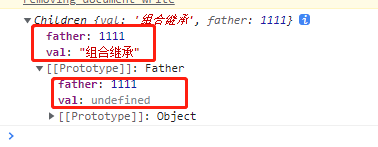组合继承(为什么叫组合继承,组合继承就是构造函数继承和原型链继承的组合)
// 组合继承(只需要注意两点) // 第一点:继承father的属性值。在Children构造函数中调用Father.call(this,val) (构造函数继承) // 第二点:继承father的方法。let aa = new Father()之后可以aa.getVal(),让Children.prototype = aa,这样Children的实例就可以用到Father的方法了(把子类的prototype设置为父类的实例,也叫做原型链继承) function Father(val){ this.val = val this.father = 1111 } function Children(val){ Father.call(this,val) //构造函数继承:解决原型链继承的缺点:解决了原型链继承造成的引用类型被所有实例共享的问题,但是缺点是function也是引用类型,这样的话就造程了每个子实例都会有相同的方法,造成了内存浪费 } Children.prototype = new Father() //原型链继承 Father.prototype.getVal = function(payload = ''){ console.log(this.val + payload) } let child = new Children("组合继承") console.log(child)
运行出来的结果如下

所以组合继承的缺点也是很明显,就是在继承父类函数的时候调用了父类构造函数,导致子类的原型上多了不需要的父类属性,造成了内存上的浪费
寄生组合继承
function Parent(value) {
this.val = value
}
Parent.prototype.getValue = function() {
console.log(this.val)
}
function Child(value) {
Parent.call(this, value)
}
Child.prototype = Parent.prototype
Parent.prototype.constructor = Child
const child = new Child(1)
child.getValue() // 1
child instanceof Parent // true
es6 class继承
class Parent {
constructor(value) {
this.val = value
}
getValue() {
console.log(this.val)
}
}
class Child extends Parent {
constructor(value) {
super(value)
this.val = value
}
}
let child = new Child(1)
child.getValue() // 1
child instanceof Parent // true
class 实现继承的核心在于使用 extends 表明继承自哪个父类,并且在子类构造函数中必须调用 super,因为这段代码可以看成 Parent.call(this, value)。
当然了,之前也说了在 JS 中并不存在类,class 的本质就是函数。